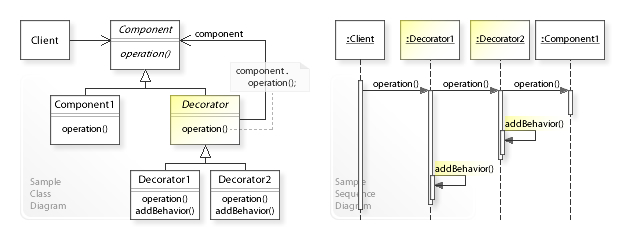Intent

The decorator pattern can be used to extend (decorate) the functionality of a certain object statically, or in some cases at run-time, independently of other instances of the same class, provided some groundwork is done at design time. This is achieved by designing a new Decorator class that wraps the original class. This wrapping could be achieved by the following sequence of steps:
- Subclass the original Component class into a Decorator class (see UML diagram);
- In the Decorator class, add a Component pointer as a field;
- In the Decorator class, pass a Component to the Decorator constructor to initialize the Component pointer;
- In the Decorator class, forward all Component methods to the Component pointer; and
- In the ConcreteDecorator class, override any Component method(s) whose behavior needs to be modified.
This pattern is designed so that multiple decorators can be stacked on top of each other, each time adding a new functionality to the overridden method(s).
Note that decorators and the original class object share a common set of features. In the previous diagram, the operation() method was available in both the decorated and undecorated versions.
The decoration features (e.g., methods, properties, or other members) are usually defined by an interface, mixin (a.k.a. trait) or class inheritance which is shared by the decorators and the decorated object. In the previous example, the class Component is inherited by both the ConcreteComponent and the subclasses that descend from Decorator.
The decorator pattern is an alternative to subclassing. Subclassing adds behavior at compile time, and the change affects all instances of the original class; decorating can provide new behavior at run-time for selected objects. [5]
This difference becomes most important when there are several independent ways of extending functionality. In some object-oriented programming languages, classes cannot be created at runtime, and it is typically not possible to predict, at design time, what combinations of extensions will be needed. This would mean that a new class would have to be made for every possible combination. By contrast, decorators are objects, created at runtime, and can be combined on a per-use basis. The I/O Streams implementations of both Java and the .NET Framework incorporate the decorator pattern. [5]

